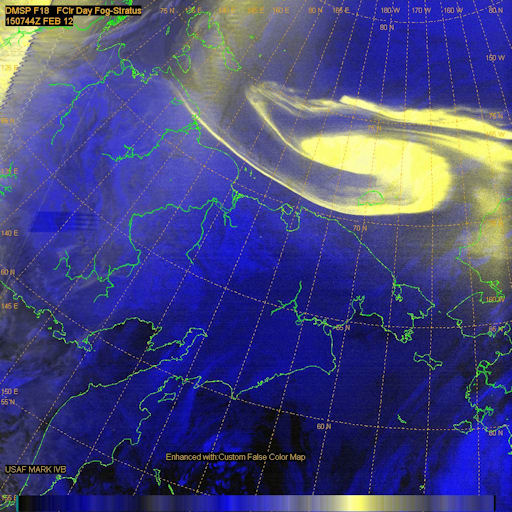QUIET SUN: With no sunspots actively flaring, the sun's output has flatlined again. NOAA forecasters put the chance of an M-class flare during the next 24 hours at no more than 1%. Solar activity should remain low. Solar flare alerts: text, voice.
AURORA WHIRLPOOL: Sometimes the sky surprises us. On Feb. 14-15, with little warning, geomagnetic activity rippled around the Arctic Circle, producing an outbreak of auroras that veteran observers said was among the best in months. At the height of the display, a US Defense Meteorological Program satellite photographed a whirlpool of Northern Lights just north of the Bering Sea:
"A number of images from the DMSP F18 satellite captured the dramatic auroral event of the last couple nights," says analyst Paul McCrone, who processed processed the data at the US Navy's Fleet Numerical Meteorology and Oceanography Center in Monterey, CA.
The reason for the outburst is still not completely clear. It got started on Feb. 14th when a magnetic disturbance rippled around the Arctic Circle. No CME was obvious in local solar wind data at the time; the disturbance just ... happened. Once begun, the disturbance was amplified by the actions of the interplanetary magnetic field (IMF) near Earth. The IMF tipped south, opening a crack in our planet's magnetic defenses. Solar wind poured in and fueled the auroras.
more images: from Göran Strand of Östersund, Sweden; from Heidi Pinkerton of Birch Lake, Babbitt, Minnesota; from Roger Schneider of Tromso, Norway; from Hanneke Luijting of Tromsø, Norway; from Peter Rosén of Abisko NP, Sweden; from Jesper Grønne of Silkeborg Denmark

![]()
Solar wind
speed: 367.8 km/sec
density: 0.0 protons/cm3
explanation | more data
Updated: Today at 1436 UT
![]()
X-ray Solar Flares
6-hr max: B2 1025 UT Feb16
24-hr: B2 1025 UT Feb16
explanation | more data
Updated: Today at: 1400 UT
![]()
![]()
![]()
Daily Sun: 16 Feb 12
![]()
![]()
With no sunspots actively flaring, the sun's x-ray output has flatlined. Credit: SDO/HMI
![]()
![]()
![]()
Sunspot number: 40
What is the sunspot number?
Updated 15 Feb 2012
Spotless Days
Current Stretch: 0 days
2012 total: 0 days (0%)
2011 total: 2 days (<1%)
2010 total: 51 days (14%)
2009 total: 260 days (71%)
Since 2004: 821 days
Typical Solar Min: 486 days
Updated 15 Feb 2012
The Radio Sun
10.7 cm flux: 105 sfu
explanation | more data
Updated 15 Feb 2012
![]()
![]()
![]()
Current Auroral Oval:
![]()
Switch to: Europe, USA, New Zealand, Antarctica
Credit: NOAA/POES
![]()
![]()
![]()
Planetary K-index
Now: Kp= 1 quiet
24-hr max: Kp= 4 unsettled
explanation | more data
![]()
Interplanetary Mag. Field
Btotal: 3.5 nT
Bz: 3.2 nT north
explanation | more data
Updated: Today at 1437 UT
![]()
![]()
![]()
Coronal Holes: 15 Feb 12
![]()
![]()
Solar wind flowing from this coronal hole could reach Earth on Feb. 17-18. However, the solar wind stream is likely to sail south of our planet, making little impact. Credit: SDO/AIA.





